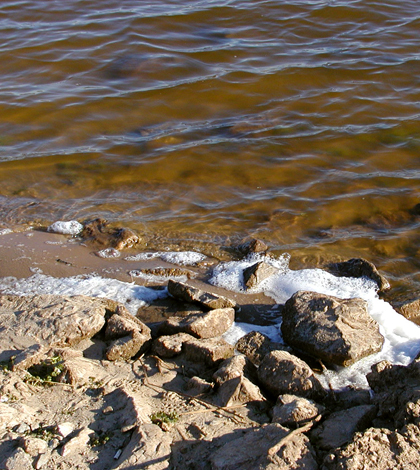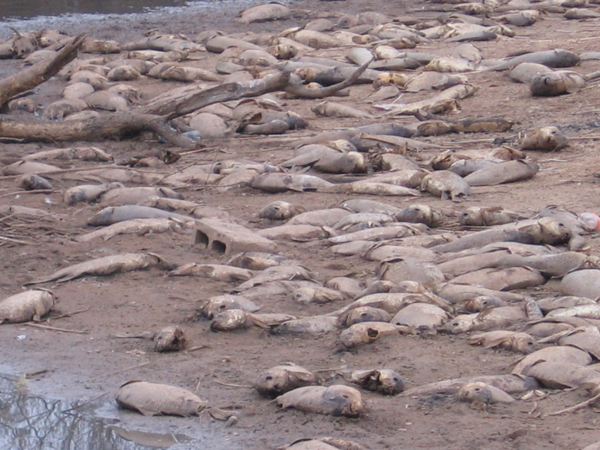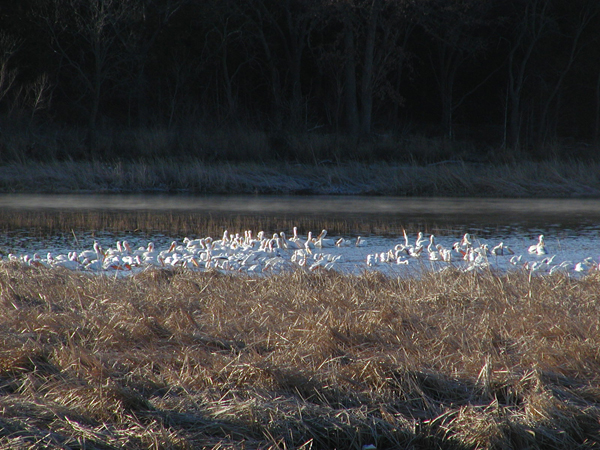Six months after Lake Texoma fish kill, populations completely recovered

A golden algae bloom on Lake Texoma induced a fish kill (Credit: Oklahoma Department of Wildlife Conservation)
Every year, Prymnesium parvum — known also as golden algae — blooms in bodies of water across the world, debilitating ecosystems and killing off entire fish assemblages. However, a study recently published in Freshwater Science showed that fish assemblages in one Great Plains cove recovered within six months of total elimination.
Lake Texoma, shared by Oklahoma and Texas, has suffered annual algae blooms since 2004. The blooms have killed off fish populations each year in one of the lake’s coves: Lebanon Pool.
Rich Zamor, a postdoctoral researcher at the University of Oklahoma and lead author of the study, said the research strived to answer several questions.
“Are there any long term effects that these assemblages have on the fish community as a whole?” Zamor said. “Is there any possibility to lose species? What would be the effect on the fisheries?”
Eutrophication and subsequent fish kills have been the subject of many studies, Zamor said. But researchers working on this one had a unique advantage.
“One of the interesting things [about this study] is that we had a pretty good idea that a fish kill was going to come,” said Nathan Franssen, postdoctoral researcher at the University of New Mexico and study co-author. “There’s not a lot of data on fish assemblages before these blooms.”
The researchers wanted a complete set of data from before and after the bloom and subsequent fish kill. To do this, they collected fish samples on a monthly basis starting in October of 2008. The researchers used seines for fish near the shore, and larger gill nets in the deeper parts of the cove.

A 2004 fish kill on Lake Texoma (Credit: University of Oklahoma Plankton Ecology and Limnology Lab)
The researchers preserved the fish on-site before returning to the lab, where they sorted the fish by species. From there, the researchers counted the members of each species and took size measurements.
A long-standing monitoring program on Lake Texoma provided researchers with valuable insight into the hydrological condition of the local ecosystem. At two sites, Lebanon Pool and Wilson Creek Cove, monthly field assessments collected data for dissolved oxygen, nutrient loads and toxic algae.
“There were no reports of fish kill in Lebanon Pool,” Franssen said. “The only way that we had any indication that there was a fish kill was some of the algae monitoring data and us being out there with seines and gill nets.”
During the algae bloom period from December 2008 to May 2009, the researchers were unable to catch a single fish in Lebanon Pool, despite having caught thousands just months before. Stranger still, no dead fish seemed to have washed up on the shore.
“Because we weren’t able to catch any fish, and we didn’t see any dead fish on the side, we really had to investigate and look where the fish went,” Zamor said.
One possible answer came from above.
“There are these large flocks of pelicans that have started showing up in that cove since 2006, right around the time of the bloom periods,” Zamor said. “What we think happened is that they consumed most of the dead fish before they arrived on shore.”

Despite the lack of fish in the scientists’ nets after the 2008 fish kill, no carcasses showed up on shore. Pelicans on the lake may have eaten them all. (Credit: Oklahoma Department of Wildlife Conservation)
Franssen and Zamor stressed that this is a hypothesis that has not been tested.
Wherever the fish went, the study found that fish assemblages in Lebanon Pool returned to full strength six months after the deadly algae bloom. This isn’t a typical timeframe, however, as recovery time is based on the individual relationship between a fish assemblage and its habitat, Zamor said.
“In this situation…Lebanon Pool actually becomes isolated from the lake for part of the year,” Zamor said. “When spring floods come, the lake rises and fish come in from everywhere and recolonize really quickly.
“We really don’t have a good idea of how long it takes to recover from any given algae bloom. This is really one of the first studies to look at that,” he said. “After a fish kill, if there isn’t a source of new migrants from a neighboring community, then the community is not going to recover.”
For instance, Lake Granbury in Texas suffers from lakewide blooms and recovers at a slower rate than Lebanon Pool, Zamor said. The nearby Pecos River took 18 months to recover from one bloom.
With the exception of an instance involving floating debris and tangled nets, Franssen and Zamor said the study went smoothly until its conclusion in November 2009.
“I’ve been involved in quite a few field research projects, and this was one of the few that actually went off without a hitch,” Franssen said.
Top image: A golden algae bloom on Lake Texoma induced a fish kill (Credit: Oklahoma Department of Wildlife Conservation)




0 comments